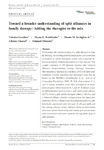Mostrar o rexistro simple do ítem
Toward a Broader Understanding of Split Alliances in Family Therapy: Adding the Therapist to the Mix
| dc.contributor.author | Escudero Carranza, Valentín | |
| dc.contributor.author | Friedlander, Myrna L. | |
| dc.contributor.author | Kivlighan, Dennis M. | |
| dc.contributor.author | Abascal, Alberto | |
| dc.contributor.author | Orlowski, Edmund | |
| dc.date.accessioned | 2022-06-29T09:48:08Z | |
| dc.date.available | 2022-06-29T09:48:08Z | |
| dc.date.issued | 2022-03 | |
| dc.identifier.citation | Escudero, V., Friedlander, M. L., Kivlighan, D. M., Abascal, A., & Orlowski, E. (2022). Toward a broader understanding of split alliances in family therapy: Adding the therapist to the mix. Family Process, 61, 167– 182. https://doi.org/10.1111/famp.12718 | es_ES |
| dc.identifier.uri | http://hdl.handle.net/2183/31023 | |
| dc.description | Financiado para publicación en acceso aberto: Universidade da Coruña/CISUG | es_ES |
| dc.description.abstract | [Abstract] To broaden our understanding of a split alliance in fam-ily therapy, we investigated the frequencies and correlates of sessions in which therapists, youth, and caregivers re-ported markedly different perceptions of the alliance. The sample consisted of 156 Spanish families who received Alliance Empowerment Family Therapy (Escudero, Adolescentes y familias en conf licto, 2013) for child mal-treatment. Family members and therapists rated the al-liance on the SOFTA-s (Friedlander et al., Journal of Counseling Psychology, 2006, 53, 214) after sessions 3, 6, and 9; family members rated their perceptions of treat-ment progress before sessions 4, 7, and 10. A cluster analy-sis differentiated sessions with a split adult- youth alliance(27.7%) from a split family- therapist alliance (44.1%), and a balanced alliance (similar ratings across the three per-spectives; 28.2%). Client- rated treatment progress was dif-ferentially associated with the type of alliance split and the average alliance rating, whereas better posttreatment outcomes (child functioning and family goal attainment) were associated with fewer sessions having either type of split alliance | es_ES |
| dc.description.sponsorship | This study was carried out with the collaboration of the Program for Therapeutic Treatment of Children and Adolescents at Risk, financed by the Xunta de Galicia, Spain | |
| dc.language.iso | eng | es_ES |
| dc.publisher | Wiley | es_ES |
| dc.relation.uri | https://doi.org/10.1111/famp.12718 | es_ES |
| dc.rights | Atribución-NoComercial-SinDerivadas 4.0 Internacional | es_ES |
| dc.rights.uri | http://creativecommons.org/licenses/by-nc-nd/4.0/ | * |
| dc.subject | Therapeutic alliance | es_ES |
| dc.subject | Split alliance | es_ES |
| dc.subject | SOFTA | es_ES |
| dc.subject | Child maltreatment | es_ES |
| dc.subject | Family Therapy Process | es_ES |
| dc.subject | Alianza terapéutica | es_ES |
| dc.subject | Alianza dividida | es_ES |
| dc.subject | Maltrato infantil | es_ES |
| dc.subject | Terapia de familia | es_ES |
| dc.title | Toward a Broader Understanding of Split Alliances in Family Therapy: Adding the Therapist to the Mix | es_ES |
| dc.type | info:eu-repo/semantics/article | es_ES |
| dc.rights.access | info:eu-repo/semantics/openAccess | es_ES |
| UDC.journalTitle | Family Process | es_ES |
| UDC.volume | 61 | es_ES |
| UDC.issue | 1 | es_ES |
| UDC.startPage | 167 | es_ES |
| UDC.endPage | 182 | es_ES |
| dc.identifier.doi | 10.1111/famp.12718 |






